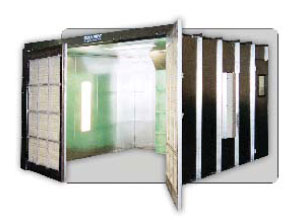Spray Booth Brush-Up: How to Buy the Right Paint Booth

Crossdraft Spray Booth
In the market for a new spray booth? Some things to consider.
The National Fire Protection Association (NFPA), Chapter 33, defines a spray booth as:
“A power-ventilated enclosure for a spray application operation or process that confines and limits the escape of the material being sprayed, including vapors, mists, dusts and residues that are produced by the spraying operation and conducts or directs these materials to an exhaust system.”
Before deciding on the size and airflow configuration of a paint spray booth, you should first consider: the size of the parts to be painted; the finish that is required; the coatings to be applied; the type of application system, if the paint booth needs to be enclosed; and the available budget may also be a factor.
The area where the paint booth will be placed should also taken into consideration, as oftentimes the floor space available will be limited.
Spray Booth Placement
The egress code requires a minimum 3-ft. clearance on any side of the booth requiring personnel access (NFPA 101Life Safety Code). As a general rule, the interior size of the paint booth should be large enough to allow the painter access to all sides of the product to be sprayed (I recommend a minimum of 3-ft. clearance around the part). This size rule should be considered minimum regardless of the application system (airless, air-assisted airless, conventional, electrostatic or HVLP). Electrostatic and HVLP spray are typically applied at lower pressure and at a closer distance so the fan pattern could possibly be adversely affected by a booth with a high rate of airflow.
Types of Spray Booths
The expected production or volume of painting that is anticipated will affect the general layout of the finishing area more than the size and type of booth. Correctly laid out, small, relatively inexpensive, open front booths can be utilized quite effectively in high-production shops.
Generically, there are four basic types of paint spray booths:
1.$ Crossdraft Booth: Air enters one end and exits the opposite end of the booth. Note: Open Industrial Booths are crossflow paint booths.
2.$$ Semi-crossdraft Booth: Air enters through the roof at one end and exits out the opposite end of the booth. This is sometimes referred to as semi-downdraft or modified downflow.
3.$$$ Side-downdraft Booth: Air enters through the roof and exits both sides along the floor. Also sometimes referred to as semi-downdraft.
4.$$$$ Downdraft Booth: Air enters through the roof and exits through the floor — generally this style booth utilizes a pit in the floor; however, this type booth can be mounted above ground on a basement exhaust plenum. Downdraft booths utilize gravity as the air draft moves directly downward through the paint area, and this design is considered the premier booth airflow — it is also the most expensive.
Deciding on an enclosed booth or an open-type booth should be an easy decision. If the area around the booth is moderately dust-free and the paint is of a fast drying nature (i.e., lacquer), then an open front booth will suffice. If the environment around the booth is likely to contaminate the paint as it is applied, or if the coating applied is slow to dry (i.e., conventional alkyd coating), then an enclosed booth would be the correct choice.
The type of airflow selected may be determined simply by the budget available, or it may be determined by the personal preference of the painter. Even though one airflow design may be preferred over anoth er, a quality paint finish can be achieved in all four types of paint booths when used by a competent painter. As for the type of coat ing being applied, it really will not matter since the paint booth is only evacuating the overspray and fumes.
Filters
A paint booth is only as good as the filters it uses. If the booth is enclosed, there will be intake air filters that remove the majority of airborne contaminants. If these filters are of a low quality or do not seal well, you may expect to see contami nation within the enclosure. Similarly, exhaust filters that are low quality will allow overspray to migrate through the exhaust stack.
You must change out dirty filters in order to maintain proper airflow. Most booths utilize a manometer as a visual signal to the operator when it is time to change out the filters. The manometer indicates the pressure differential (in inches) from inside the work area of the booth (in front of the filter) and inside the exhaust chamber (behind the filter); when this pressure reaches the limits of the fan (usually between ¾ to 1 in.) then it is time to replace the filters. If the filters are not replaced, the booth will continue to function but with an ever-decreasing airflow.
Compliant Paint Booths is a national paint booth supplier specializing in automotive spray booths and industrial paint booths. For expert paint booth advise , call 1-800.609.6408.